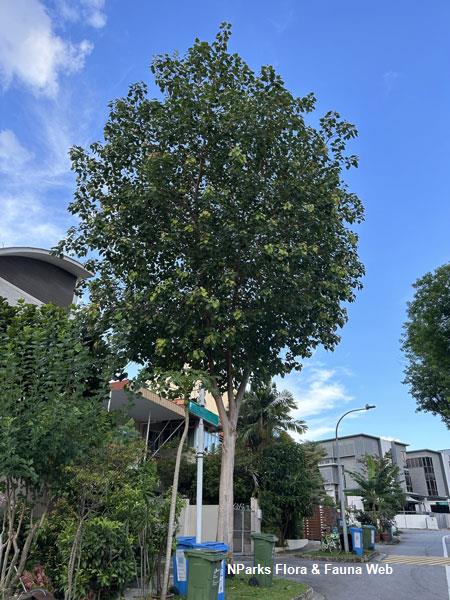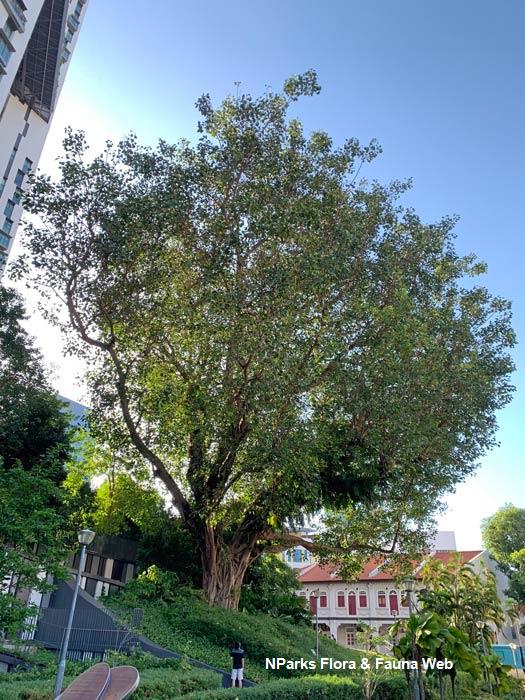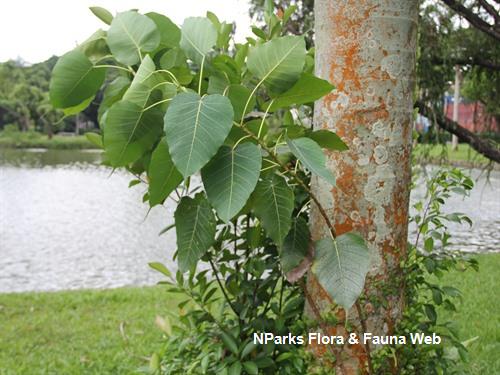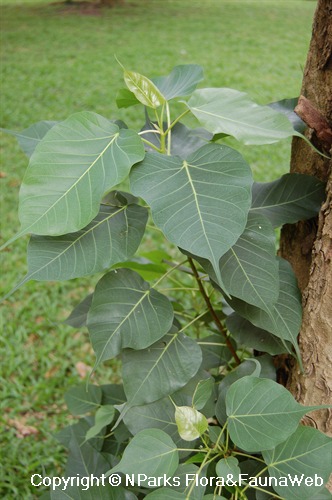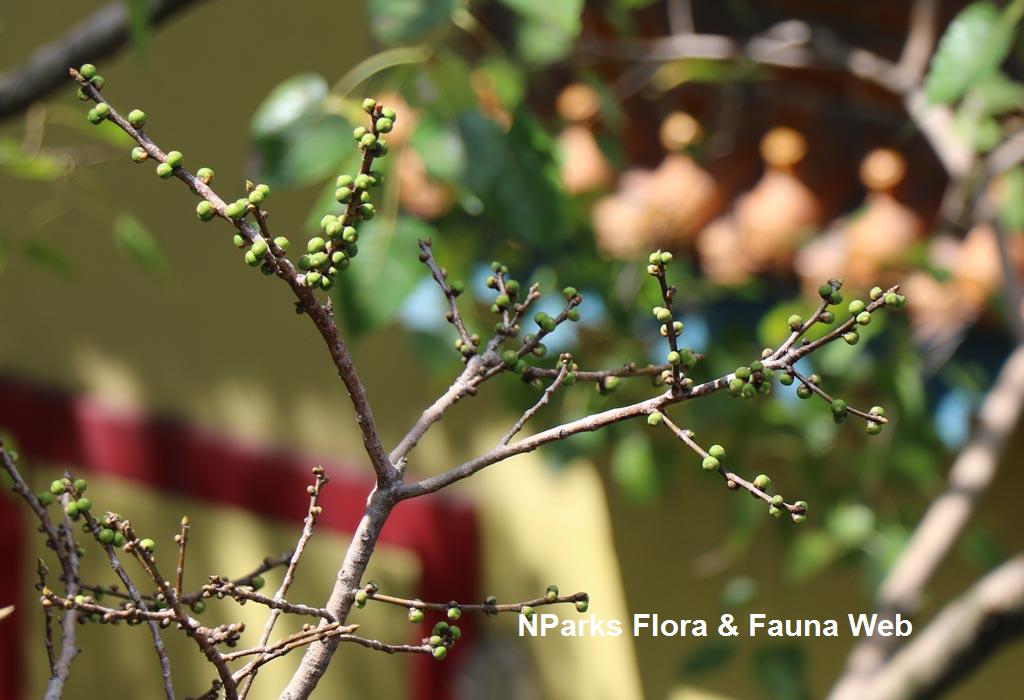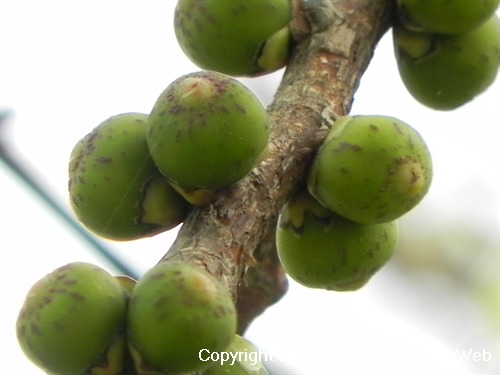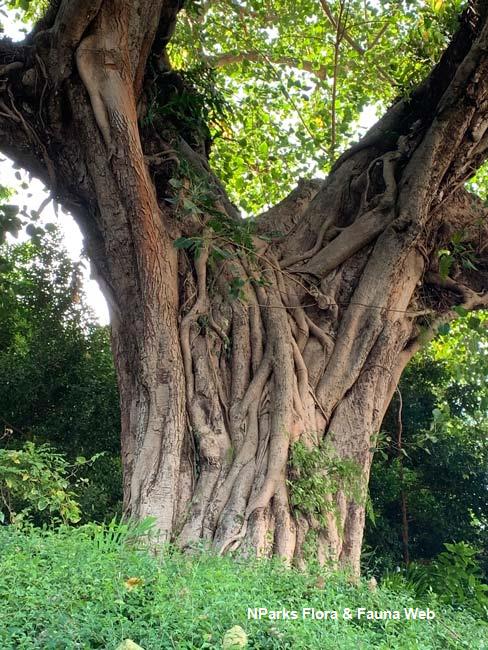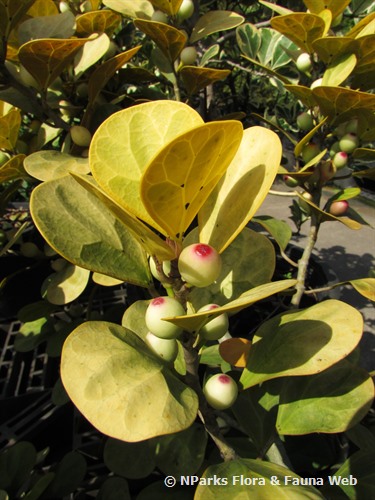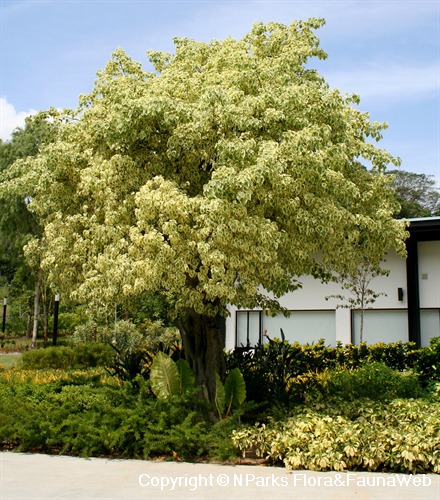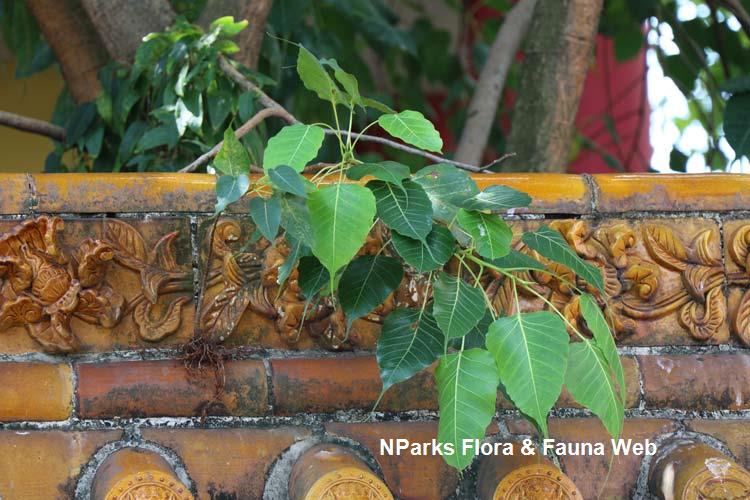
Back
Ficus religiosa L.
| Family Name: | Moraceae |
| Common Name: | Bodhi Tree, Sacred Fig Tree, Pipul Tree, Budi, Pipal Tree, Pepul Tree, Bo Tree, Bodi, Ara Budi, Peepul Tree, 菩提树 |
Ficus religiosa is a strangler fig tree with broadly ovate to heart-shaped leaves. The leaf tip is characteristically narrow and long, measuring about 2 – 5 cm long. It is a sacred tree to Hinduism and Buddhism and is often cultivated in temples.
Name
Classifications and Characteristics
| Plant Division | Angiosperms (Flowering Seed Plants) |
|---|---|
| Plant Growth Form | Tree |
| Lifespan (in Singapore) | Perennial |
| Mode of Nutrition | Autotrophic |
| Maximum Height | 25 m to 35 m |
Biogeography
| Native Distribution | Some parts of Asia. |
|---|---|
| Native Habitat | Terrestrial |
| Preferred Climate Zone | Tropical |
| Local Conservation Status | Non-native (Spontaneous (Naturalised)) |
Description and Ethnobotany
| Growth Form | It is a tree or hemi-epiphyte, which can reach up to 25 (–35) m tall. It is a strangler fig which may begin its life on another plant. After the roots reach the ground, it begins to strangle its host and eventually replaces it. When cultivated directly in the ground, it usually has only a few aerial roots. Bark is grey, smooth or finely fissured. It produces white sap when any parts of the plant are injured. |
|---|---|
| Foliage | The leaves are spirally arranged and leathery. They are broadly ovate to heart-shaped (cordiform), measuring about (5–) 10 – 20 (–27) cm long and (2.5–) 8 – 13 (–17) cm wide. The leaf tip is characteristically narrow and long (about 2 – 5 cm long) while the leaf base is cordate to truncate. The Leaf margin is entire or wavy (undulate). Cystoliths are present on the underside of the leaves. Each leaf has (6–) 7–9 pairs of lateral veins. The petiole is (2.5–) 4 – 12 cm long. The stipules is 0.5 – 1 cm long and it can be hairless (glabrous) or bearing a fringe of hairs along the margin (ciliate). The stipules may fall off early (caducous) or sometimes persistent at the terminal ends of the branches and forming a terminal bud. |
| Fruit | The figs (syconia) are sessile and occur at the leaf axils in clusters of 1 – 2. Each fig has 3 bracts at the base. These bracts are 3 – 5 mm long, persistent and often splitting into lobes at the tip. The fig is subglobose (about 0.5 – 0.8 (–1) cm diameter) and they turn purple to black at maturity. The tip of the fig can be concave to flat. The ostiole is prominent to flat (about 2 – 2.5 mm diameter). The ovary is red-brown. |
| Associated Fauna | It is pollinated by fig wasps (Blastophaga quadriceps). In Singapore, fruits are eaten and dispersed by birds and small mammals, such as Yellow-vented Bulbul (Pycnonotus goiavier), Coppersmith Barbet (Megalaima haemacephala indica), Cuckoo (Cacomantis and Cuculus species) and Squirrels (Callosciurus species). <9> |
| Etymology | Ficus, in Latin, refers to the commercial edible fig (Ficus carica). The specific epithet religiosa, in Latin, means sacred, alluding to the religious significance of the tree. |
| Ethnobotanical Uses | Medicinal: Traditional Medicinal Uses In India, it is used in traditional medicine to treat an array of illnesses ranging from diabetes, ulcers and skin diseases <4, 6>. In Vietnam, the aerial roots are used to treat ascites <4,6>. It is important to note that some therapeutic effects from traditional medicinal uses of plants are not currently supported or verified by scientific research. Timber & Products: The bark is used to tan leather, dye cloths and make paper. The wood is used to make packing cases and matches <4>. Cultural / Religious: It is a sacred tree to Hinduism and Buddhism as it is believed that Buddha attained his spiritual enlightenment while meditating under the tree. It is often cultivated in Buddhist temples. The dried leaves are often painted with religious images and sold as souvenirs in temple grounds. The tree in Anuradhapura, Sri Lanka, is said to be the world’s oldest cultivated tree. It is recorded to be over 2300 years old. Heritage Tree: There are 4 individuals of Ficus religiosa listed as Heritage Trees in Singapore. They are found all over various parts of Singapore. To find out more about these trees, please visit the Heritage Tree Register. Others: The white latex is harvested and used as birdlime <4>. |
Landscaping Features
| Landscape Uses | Parks & Gardens |
|---|
Fauna, Pollination and Dispersal
| Fauna Pollination Dispersal Associated Fauna | Bird-Attracting (Fruits) |
|---|---|
| Pollination Method(s) | Biotic (Fauna) (Insects (Ant, Beetle, Fly, Thrip, Wasp), Associated with: Blastophaga quadriceps) |
| Seed or Spore Dispersal | Biotic (Fauna) |
Plant Care and Propagation
| Light Preference | Full Sun, Semi-Shade |
|---|---|
| Water Preference | Moderate Water |
| Plant Growth Rate | Moderate |
| Rootzone Tolerance | Well-Drained Soils, Fertile Loamy Soils |
| Propagation Method | Seed, Stem Cutting |
Foliar
| Mature Foliage Colour(s) | Green |
|---|---|
| Mature Foliage Texture(s) | Leathery |
| Prominent Young Flush Colour(s) | Pink |
| Foliar Type | Simple / Unifoliate |
| Foliar Arrangement Along Stem | Spiral |
| Foliar Attachment to Stem | Petiolate |
| Foliar Shape(s) | Non-Palm Foliage (Ovate, Cordate) |
| Foliar Margin | Entire - Wavy / Undulate |
| Foliar Apex - Tip | Caudate |
| Foliar Base | Cordate, Truncate / Square |
| Leaf Area Index (LAI) for Green Plot Ratio | 3.0 (Tree - Intermediate Canopy) |
Non - Foliar and Storage
| Trunk Type (Non Palm) | Woody |
|---|---|
| Mature Bark Texture | Smooth, Fissured |
| Root Type | Underground |
Fruit, Seed and Spore
| Mature Fruit Colour(s) | Purple, Black |
|---|
References
| References | <1> Berg, C.C. & Corner, E.J.H. (2005). Moraceae – Ficus. Flora Malesiana, ser. 1, Seed Plants, vol. 17, pt. 2. Leiden: Nationaal Herbarium Nederland. <2> Berg, C.C., Pattharahirantricin, N. & Chantarasuwan, B. (2011). Moraceae. In: Santisuk, T. & Larsen, K. (eds.) Flora of Thailand, vol. 10(4), pp. 475-675. Bangkok: The Forest Herbarium, Royal Forest Department. <3> Chantarasuwan, B., Berg, C.C. and van Welzen, P.C. (2013). A Revision of Ficus Subsection Urostigma (Moraceae). Systematic Botany 38 (3): 653 – 686. <4> de Padua, L.S., Lemmens, R.H.M.J. and Bunyapraphatsara, N. (eds). (1999). Plant Resources of South-East Asia Volume 12 (1). Medicinal and poisonous plants 1. Leiden: Prosea Foundation, Backhuys Publishers. 711 pages. <5> Flora of China. (2014). Ficus religiosa. Flora of China. http://www.efloras.org/florataxon.aspx?flora_id=2&taxon_id=200006369 (accessed 22 August 2019). <6> Gardner, S., Sidisunthorn, P., & Chayamarit, K. (2018). Forest Trees of Southern Thailand. Volume 3 (Mo – Z). The Forest Herbarium, Bangkok, The Royal Botanic Gardens, Kew. Pp. 1532−2401. Bangkok: Amarin Printing and Publishing Plc. <7> Keng, H. (1990). The Concise Flora of Singapore: Gymnosperms and Dicotyledons. Singapore: Singapore University Press. <8> Lindsay, S., Middleton, D.J., Ho, B.C., Chong, K.Y, Turner, I.M., Ali Ibrahim, Alonso-García, M., Ang, W.F., Ashton, P.S., Athen, P. et al. (2022). Flora of Singapore: Checklist and bibliography. Gardens Bulletin Singapore 74(Suppl. 1): 3–860. <9> Lok, A. F. S. L, Ang, W. F., Ng, B. Y. Q., Leong, T. M., Yeo, C. K. and Tan, H. T. W. (2013). Native fig species as a keystone resource for the Singapore urban environment. Raffles Museum of Biodiversity Research, National University of Singapore. |
|---|
Image Repository
Others
| Master ID | 1622 |
|---|---|
| Species ID | 2915 |
| Flora Disclaimer | The information in this website has been compiled from reliable sources, such as reference works on medicinal plants. It is not a substitute for medical advice or treatment and NParks does not purport to provide any medical advice. Readers should always consult his/her physician before using or consuming a plant for medicinal purposes. |


